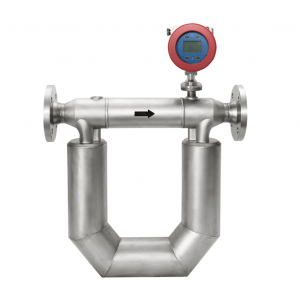It is well known that slurries in desulfurization system exhibit both abrasive and corrosive properties for its unique chemical properties and high solid content. It is difficult to measure the density of limestone slurry in traditional methods. As a result, many companies may stick into dilemma when selecting limestone slurry. At present, primary density measurements are summarized into the following three methods:
1. Differential pressure density meter;
2. Liquid level transmitter;
3. Coriolis mass flow meter.

The measurement of limestone slurry density in desulfurization systems via a mass flow meter is due to the similarity in the structural form of a mass flow meter and that of a vibrating tube density meter. The measuring tube vibrates at a certain resonant frequency in a continuous manner. The vibration frequency of the vibration tube varies when it is filled with fluids of different densities.
In conclusion, the frequency of the vibrating tube indicates the density of fluids in correspond. It’s the primary method in slurry density measurement for its high precision and wide density range for slurries. The following issues should be kept an eye on for fully adaptable to on-site requirements.
When installing the device vertically or horizontally, the measuring tube should be oriented upward to protect it from the accumulation of solid residues, which could alter the frequency of the tube and thereby affect the accuracy of the density measurement. In using the Coriolis mass flow meter for density measurement, the influence of flow rate or flow velocity on the mass flow meter is often overlooked. Although the flow rate of the medium passing through the mass flow meter does not directly impact the density measurement, high-speed flow of limestone slurry can cause significant wear on the measuring tube of the mass flow meter, thereby impacting its service life. Therefore, it is advisable to keep the flow rate through the mass meter as low as possible to extend its longevity and reduce costs.
Install the mass meter on a bypass if the flow rate in the main pipeline is too high and adjust the flow rate via a valve to prevent potential wear. It should not be installed directly at the outlet of a vertical vent pipe but rather on the pressure side of the pump (to avoid low pressure). Due to material buildup, wear, and corrosion, the mechanical structure of the measuring tube will change after long time operation, and its resonant frequency will be impacted by these factors, resulting in reduced density measurement accuracy. Field recalibration and adjustment are then required. Before long-term shutdown, the pipeline should be flushed with clean water to prevent limestone from adhering to the interior tube or even blocking the pipeline, which could lead to reduced measurement accuracy or even render measurement impossible.
Viscous fluids and the solid particles in the measured fluid cause wear on the interior of the vibrating tube of the Coriolis mass flow meter. The wear state of the vibrating tube has a certain impact on the offline calibration of the flow meter, fault diagnosis, and vibration-based measurement of fluid viscosity. The wear on the pipeline caused by solid particles can lead to rapid failure of the mass flow meter.
In contrast, ultrasonic density meters based on the acoustic impedance principle are not impacted by such particle wear. Therefore, it has an extremely long service life and is virtually unaffected by wear from particles in the slurry. Please contact Lonnmeter right now and request a free quote if you are confused about any problem.
Media Contact
Company Name: SHENZHEN LONNMETER GROUP
Email: Send Email
Country: China
Website: https://www.lonnmeter.com/


